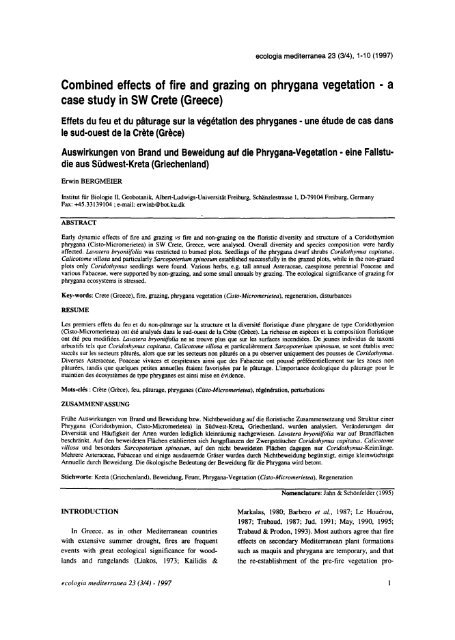1 - Ecologia Mediterranea
1 - Ecologia Mediterranea
1 - Ecologia Mediterranea
You also want an ePaper? Increase the reach of your titles
YUMPU automatically turns print PDFs into web optimized ePapers that Google loves.
ecologia mediterranea 23 (314), 1-10 (1997)<br />
Combined effects of fire and grazing on phrygana vegetation . a<br />
case study in SW Crete (Greece)<br />
Effets du feu et du pâturage sur la végétation des phryganes - une étude de cas dans<br />
le sud-ouest de la Crète (Grèce)<br />
Auswirkungen von Brand und Beweidung auf die Phrygana-Vegetation - eine Fallstudie<br />
aus Südwest-Kreta (Griechenland)<br />
Erwin BERGMEIER<br />
Institut für Biologie Il, Geobotanik, Albert-Ludwigs-Universitiit Freiburg, Schiinzlestrasse l, 0-79104 Freiburg, Germany<br />
Fax: +45.33139104 ; e-mail: erwinb@bot.ku.dk<br />
ABSTRACT<br />
Early dynamic effects of fire and grazing vs fire and non-grazing on the floristic diversity and structure of a Coridothymion<br />
phrygana (Cisto-Micromerietea) in SW Crete, Greece, were analysed. Overail diversity and species composition were hardly<br />
affected. Lavatera bryoniifolia was restricted to burned plots. Seedlings of the phrygana dwarf shrubs Coridothymus capitatus,<br />
Calicotome villosa and particularly Sarcopoterium spinosum established successfully in the grazed plots, while in the non-grazed<br />
plots only Coridothymus seedlings were found. Various herbs, e.g. tall annual Asteraceae, caespitose perennial Poaceae and<br />
various Fabaceae, were supported by non-grazing, and sorne small annuals by grazing. The ecological significance of grazing for<br />
phrygana ecosystems is stressed.<br />
Key-words: Crete (Greece), fire, grazing, phrygana vegetation (Cisto-Micromerietea), regeneration, disturbances<br />
RESUME<br />
Les premiers effets du feu et du non-pâturage sur la structure et la diversité floristique d'une phrygane de type Coridothymion<br />
(Cisto-Micromerietea) ont été analysés dans le sud-ouest de la Crète (Grèce). La richesse en espèces et la composition floristique<br />
ont été peu modifiées. Lavatera bryoniifolia ne se trouve plus que sur les surfaces incendiées. De jeunes individus de taxons<br />
arbustifs tels que Coridothymus capitatus, Calicotome villosa et particulièrement Sarcopoterium spinosum, se sont établis avec<br />
succès sur les secteurs pâturés, alors que sur les secteurs non pâturés on a pu observer uniquement des pousses de Coridothymus.<br />
Diverses Asteraceae, Poaceae vivaces et cespiteuses ainsi que des Fabaceae ont poussé préférentiellement sur les zones non<br />
pâturées, tandis que quelques petites annuelles étaient favorisées par le pâturage. L'importance écologique du pâturage pour le<br />
maintien des écosystèmes de type phryganes est ainsi mise en évidence.<br />
Mots-e1és : Crète (Grèce), feu, pâturage, phryganes (Cisto-Micromerietea). régénération, perturbations<br />
ZUSAMMENFASSUNG<br />
Frühe Auswirkungen von Brand und Beweidung bzw. Nichtbeweidung auf die floristische Zusammensetzung und Struktur einer<br />
Phrygana (Coridothymion, Cisto-Micromerietea) in Südwest-Kreta, Griechenland, wurden analysiert. Veriinderungen der<br />
Diversitiit und Haufigkeit der Acten wurden lediglich kleinraumig nachgewiesen. Lavatera bryoniifolia war auf Brandflachen<br />
beschrankt. Auf den beweideten Flachen etablierten sich Jungpflanzen der Zwergstriiucher Coridothymus capitatus. Calicotome<br />
villosa und besonders Sarcopoterium spinosum, auf den nicht beweideten Riichen dagegen nur Coridothymus-Keimlinge.<br />
Mehrere Asteraceae, Fabaceae und einige ausdauemde Graser wurden durch Nichtbeweidung begünstigt, einige kleinwüchsige<br />
Annuelle durch Beweidung. Die okologische Bedeutung der Beweidung flir die Phrygana wied betont.<br />
Stichworte: Kreta (Griechenland), Beweidung, Feuer. Phrygana-Vegetation (Cisto-Micromerietea). Regeneration<br />
INTRODUCTION<br />
In Greece, as in other <strong>Mediterranea</strong>n countries<br />
with extensive summer drought, tires are frequent<br />
events with great ecological signifIcance for woodlands<br />
and rangelands (Liakos, 1973; Kailidis &<br />
ecologia mediterranea 23 (3/4) - 1997<br />
Nomenclature: Jahn & Schonfelder (1995)<br />
Markalas, 1980; Barbero et al., 1987; Le Houérou,<br />
1987; Trabaud, 1987; Jud, 1991; May, 1990, 1995;<br />
Trabaud & Prodon, 1993). Most authors agree that fIre<br />
effects on secondary <strong>Mediterranea</strong>n plant formations<br />
such as maquis and phrygana are temporary, and that<br />
the re-establishment of the pre-fIre vegetation pro-
















